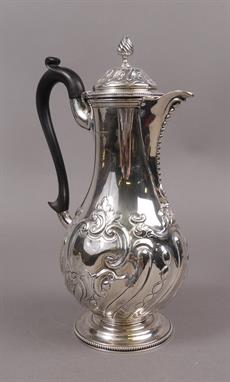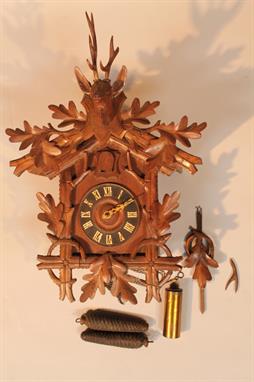We found 116061 price guide item(s) matching your search
There are 116061 lots that match your search criteria. Subscribe now to get instant access to the full price guide service.
Click here to subscribe- List
- Grid
-
116061 item(s)/page
19th Century French ebonised cased mantel clock, the case of rectangular stepped form with applied ormolu wreath and foliate mount, off-white enamel dial with Roman and Arabic numerals, brass movement striking on a bell, 36cm high Condition Report: Case - Block feet are old replacements, finial to top is a probable replacement. Dial - some restoration at edge between 5 and 6, various hairlines around other areas of rim - This is a cosmetic report only we do not comment on the workings of clocks -**
Russian dagger Kindjal, double edged blade 34cm with single off-set fuller on each side, the hilt and scabbard of niello decorated in floral patterns, with shaped pommel and two large rivets to front, the scabbard with single suspension ring and spherical finial to end Condition Report: Please see extra images. TELEPHONE department if you wish to talk through this lot - ** General condition consistent with age
Brass barrelled flintlock blunderbuss, with two stage 37cm barrel belled at the muzzle, flat pitted lock, cock replaced, full stocked, brass mounts including butt-plate, trigger-guard with acorn finial, side plate with later ramrod Condition Report: Please see extra images. TELEPHONE department if you wish to talk through this lot - ** General condition consistent with age
Single barrel flintlock sporting gun, 123cm barrel in octagonal round section, engraved at tang, flat lock-plate, brass trigger guard with pineapple finial, walnut half-stock, extensively damaged at breech, chequered at wrist Condition Report: Please see extra images. TELEPHONE department if you wish to talk through this lot - ** General condition consistent with age
A QUEEN ANNE STYLE WALNUT STICK BAROMETER IN THE MANNER OF DANIEL QUARE, the silvered dials enclosed within a glazed rectangular case and surmounted by a central turned brass finial flanked by conforming adjusters, the circular section pillar above a spiral turning and brass-banded cylindrical base, early 20th century, 100cm high. See illustration
A 19TH CENTURY FRENCH ORMOLU AND PORCELAIN-MOUNTED CLOCK GARNITURE, the clock with Japy Frères cylinder movement, numbered C1509 and 2493, the circular porcelain dial with Roman numerals, in a heavily relief cast and ornamented case of architectural form, decorated with foliage, paterae, ribbons, beading and other devices, incorporating porcelain panels, painted, jewelled and gilt in the Sèvres manner, flanked by pillars and surmounted by a two-handled urn finial, on fluted and beaded toupie feet, 42.5cm high, together with a pair of conforming urn side ornaments, 37cm high, all on fabric covered, shaped rectangular gilt gesso stands. See illustration
A VICTORIAN SILVER CLARET JUG BY CHARLES EDWARDS, LONDON 1880, the ovoid glass body engraved centrally with a band of entwined flowering branches between bands of hobnail cutting, circular foot, star cut base, the silver gilt mounts heavily chased and pierced and reserved with a panel engraved with cursive initials, the hinged cover with sworl finial, contained in a silk lined and fitted leather case stamped for Howell James & Co., Regent Street
A WILLIAM IV SILVER TEAPOT, by the Barnards, London 1836, of compressed melon form, the hinged cover with melon and leaf finial, the fluted spout with anthemion terminal, the hollow handle with ivory insulators, the cast base rim with four splay anthemion feet, together with a matching two-handled sugar basin with gilt interior, London 1833, total approximate weight 37.5cm (2)
A SILVER AND CHAMPLEVÉ ENAMEL CASKET MAKER’S MARK OF PAVEL OVCHINNIKOV WITH THE IMPERIAL WARRANT, MOSCOW, CIRCA 1876, 91 STANDARD Height 11 cm. Rectangular, the body enamelled in the Old Russian style in red, blue and green, the centre designed as a towel, the domed cover with a ball finial, the underside resting on four bun feet, with later soviet control marks.
* A VERY FINE AND RARE PRESENTATION SILVER-GILT AND PLIQUE-À-JOUR ENAMEL SET PAVEL OVCHINNIKOV, MOSCOW, CIRCA 1895, HAND ENDGRAVED SIGNATURE IN CYRILLIC ON A SMALLER KOVSH Height of the beaker 12 cm, length of the larger kovsh 20 cm, of a smaller 11.5 cm each. Comprising: a large beaker of tapering form, the body decorated with panels of stylised foliage on blue ground within white beaded borders alternating with panels depicting brightly-coloured tropical birds and a Chinese man dressed in yellow robes, twisted cable rims, supported on domed circular foot; a large kovsh with shallow bowl on raised foot, raised prow terminating with cone finial with flat shaped fleur-de-lys handle, enamelled with panels of birds, butterflies and foliage within blue-beaded borders, twisted cable rim; two small kovshi of typical form with circular bowls on raised foot and palmette-shaped flat handles, one decorated with stylised flower heads and scrolling foliage, the other with alternating turquoise and blue bean-shaped panels enamelled with stylised foliage within blue-beaded border and twisted cable rim, with a hand engraved signature in Cyrillic “Rab. P. Ovchinnikova synovia” under base; held in original case. Plique-à-jour enamel – one of the most elegant and difficult enamelling techniques – became very popular in Russia towards the end of the 19th century. Fine wares and decorative objects executed in plique-à-jour enamel are considered to be the pinnacle of craftsmanship as only a handful of jewellers in the world could work in this technique, amongst them, Pavel Ovchinnikov. The report from the All-Russia Exhibition held in Moscow in 1882, credited Pavel Ovchinnikov with the revival of this long-lost technique. The master craftsmen from his firm were among the first to start producing objects with plique-à-jour enamel. The production of plique-à-jour is technically very challenging and time-consuming, even the top masters would need to carry out several experiments before achieving the desired effect and colour. The enameller had to be not only an accomplished painter, but also a superb technician. Very often due to technical issues, plique-à-jour enamel objects were destroyed at the very last stages of production, which makes them even more rare and desirable. Although many shapes of types of objects could be executed in plique-à-jour, the Russian masters favoured the traditional forms of the kovsh, beakers, spoons and boxes etc. Plique-à-jour enamels have always been very expensive and were comparable to gems. Notwithstanding their apparent fragility, the enamel objects (which were fired at high temperatures) will keep their rich and vibrant colours for centuries. The variety of forms, richness of colours together with the excellent condition of the set, which has been kept in its original presentation box, make this a unique and rare example of the craftsmanship of the enamellers working for Pavel Ovchinnikov.
A modern Continental porcelain urn, bearing marks for Sevres, with a shaped domed top, headed by an Acorn finial and flanked by cherubic bust handles, the part textured body decorated with flowers on white ground, raised above a further gilt highlighted blue ground body on a gilt base, with blue marks beneath, 49cm high.
A French 19th century mirror back console table, the mirror having shell leaf and scrolling crest and divisional frame, relief decorated with flowers, and demi lune console table with black veined marble top, carved frieze decorated with rose garland swags, raised on stop fluted turned legs united by stretchers and centralised urn finial with rose flower decoration.
An A & E Keeling globular teapot and cover, silver shaped teapot stand, spirally fluted slop bowl and coffee cup with pixie ear handle. All decorated in polychrome enamels with flower sprigs and trailing borders, teapot 16cm high. Condition Report : Teapot with a spout chip and hair crack near the handle, light graze to the tip of the finial. Slight pitting to the rim of the bowl. No further damage and free from restoration.
A large Royal Worcester ovoid pot pourri jar by John Stinton. With pierced cover having pointed finial, inner knopped cover and painted to the main body with a pair of highland cattle watering over an ozier moulded lower body. Signed John Stinton, printed puce mark, shape number 1286, date code for 1912, 30cm high. Condition Report : Inner cover broken in half and restored. No other flaws or restoration.
A late Georgian Oak Longcase Clock, having swan pediment hood with brass phoenix on ball finial, turned columns flanking the single arch top glazed door, gilt and painted floral decorated face, eight day movement with second hand and date roller. Short door case with central reeded corners, two Mahogany banded panels, lower strung panel, standing on ball feet. 19 3/4'' wide x 85'' high x 9 1/2'' deep
A Georgian longcase Clock, having swan pediment hood with applied brass decoration and central brass finial, hand painted white face with flowers and foliage, three hour movement with date roller, long door case, with central boxwood and ebony strung Mahogany panel, lower moulding, on bracket feet, 17 1/2'' wide x 83'' high x 9'' deep
LATE VICTORIAN CAST AND PLATED TWIN LIGHT FIGURAL CANDELABRUM, modelled a s a nude male, kneeling on a naturalistic domed base, raised on three scroll feet, balancing a receiver on his head issuing two scrolling foliate arms and sconces, with central floral spray finial, 10 1/2"" (26.7cm) high EST 35-50
-
116061 item(s)/page




























































